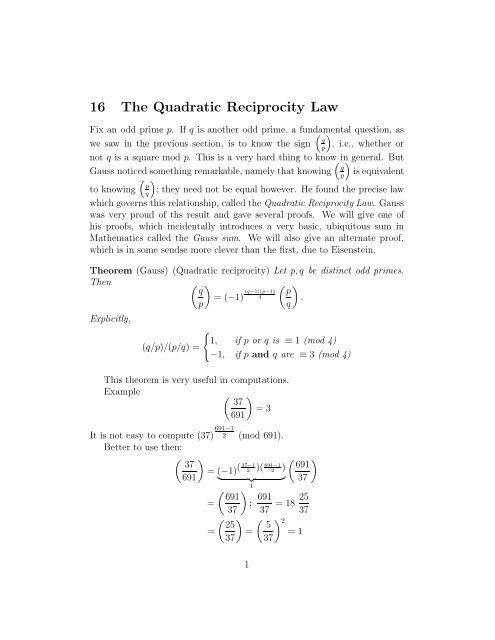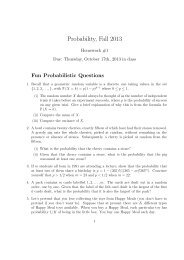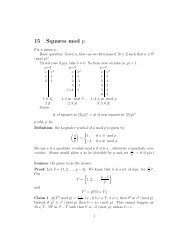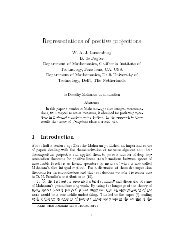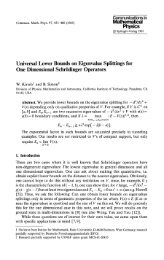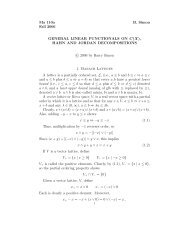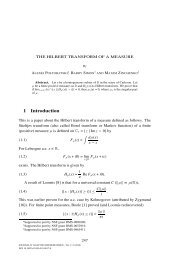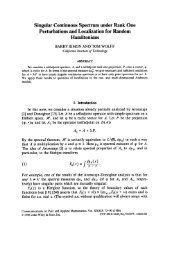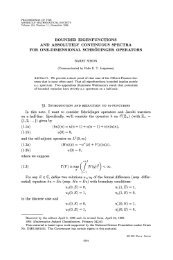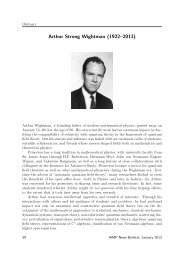16 The Quadratic Reciprocity Law - Caltech Mathematics Department
16 The Quadratic Reciprocity Law - Caltech Mathematics Department
16 The Quadratic Reciprocity Law - Caltech Mathematics Department
Create successful ePaper yourself
Turn your PDF publications into a flip-book with our unique Google optimized e-Paper software.
<strong>16</strong> <strong>The</strong> <strong>Quadratic</strong> <strong>Reciprocity</strong> <strong>Law</strong><br />
Fix an odd prime p. If q is another odd prime, a fundamental question, as<br />
q<br />
we saw in the previous section, is to know the sign , i.e., whether or<br />
p<br />
not q is a square mod p. This is a very hard thing to know in general. But<br />
q<br />
Gauss noticed something remarkable, namely that knowing is equivalent<br />
p<br />
<br />
p<br />
to knowing ;they need not be equal however. He found the precise law<br />
q<br />
which governs this relationship, called the <strong>Quadratic</strong> <strong>Reciprocity</strong> <strong>Law</strong>. Gauss<br />
was very proud of ths result and gave several proofs. We will give one of<br />
his proofs, which incidentally introduces a very basic, ubiquitous sum in<br />
<strong>Mathematics</strong> called the Gauss sum. We will also give an alternate proof,<br />
which is in some sendse more clever than the first, due to Eisenstein.<br />
<strong>The</strong>orem (Gauss) (<strong>Quadratic</strong> reciprocity) Let p, q be distinct odd primes.<br />
<strong>The</strong>n <br />
q<br />
=(−1)<br />
p<br />
(q−1)(p−1)<br />
Explicitly,<br />
<br />
p<br />
4 .<br />
q<br />
<br />
(q/p)/(p/q) =<br />
1,<br />
−1,<br />
if p or q is ≡ 1 (mod 4)<br />
if p and q are ≡ 3 (mod 4)<br />
This theorem is very useful in computations.<br />
Example <br />
37<br />
=3<br />
691<br />
It is not easy to compute (37) 691−1<br />
2 (mod 691).<br />
Better to use then:<br />
<br />
37<br />
691<br />
37−1<br />
=(−1) ( 2 )( 691−1<br />
<br />
2 ) 691<br />
37<br />
1<br />
<br />
691<br />
= ;<br />
37<br />
691 25<br />
=18<br />
37 37<br />
2 25 5<br />
= = =1<br />
37 37<br />
1
Proof#1oftheorem: p, q odd primes, p = q. Put<br />
ξ = e 2πi<br />
q ∈ C<br />
<strong>The</strong>n<br />
ξ q =1, but ξ m =1ifm
This allows us to do “congruence arithmetic” mod p in R.<br />
), Gauss introduced the following “Gauss Sum”:<br />
To study ( q<br />
p<br />
Sq = <br />
a mod q<br />
<br />
a<br />
ξ<br />
q<br />
a .<br />
Clearly, Sq ∈ R.<br />
Aside (Not part of proof of Quad. Recip., but interesting)<br />
So if<br />
Sq =<br />
2<br />
q−1<br />
a=1<br />
a<br />
q<br />
<br />
−1<br />
=1,Sq =<br />
q<br />
<br />
ξ a +<br />
2<br />
q−1<br />
a=1<br />
<br />
−a<br />
ξ<br />
q<br />
−a<br />
<br />
( −1<br />
q )( a<br />
q ) ¯ ξa <br />
<br />
a<br />
(ξ<br />
q<br />
a + ¯ ξa ) ∈ R ∩ R<br />
and if <br />
−1<br />
= −1, Sq∈ R ∩ iR<br />
q<br />
pure read or im.<br />
Lemma 1:<br />
Proof of Lemma 1:<br />
S 2 q =<br />
<br />
a mod q<br />
c mod q<br />
S 2 q =(−1) q−1<br />
2 q<br />
<br />
a<br />
ξ<br />
q<br />
a<br />
<br />
<br />
a mod q<br />
b mod q<br />
<br />
b<br />
ξ<br />
q<br />
b<br />
<br />
= <br />
<br />
a b<br />
ξ<br />
q q<br />
a mod q b mod q<br />
a ξ b<br />
= <br />
ab<br />
ξ<br />
q<br />
a+b<br />
= <br />
ξ c<br />
<br />
<br />
<br />
a(c − a)<br />
q<br />
<br />
3
So<br />
where a ′ a ≡ 1(modq).<br />
where<br />
S 2 q = <br />
c mod q<br />
= <br />
But −a 2 (1 − a ′ c)<br />
f(c) =?<br />
c ≡ 0(modq):<br />
q<br />
c mod q<br />
<br />
c<br />
ξ<br />
2 ac − a<br />
a mod q<br />
2 ′ −a (1 − a c)<br />
<br />
c<br />
ξ<br />
a mod q<br />
<br />
−1<br />
=<br />
q<br />
<br />
(−1) q−1<br />
2<br />
⇒ S 2 q =(−1) q−1<br />
2<br />
f(c) = <br />
a mod q<br />
f(0) =<br />
q<br />
q<br />
2 a<br />
q<br />
<br />
=1 as a≡0 modq<br />
<br />
c mod q<br />
′ 1 − a c<br />
q<br />
<br />
a mod q<br />
a≡0 (modq)<br />
⇒ f(0) = q − 1<br />
c ≡ 0(modq): Note that, in this case, the set<br />
ξ c f(c),<br />
<br />
,<br />
a ≡ 0modq<br />
<br />
1<br />
q<br />
{1 − a ′ c|a mod q, a ≡ 0modq}<br />
′ 1 − a c<br />
runs over elements of Z/q −{1} exactly once. Indeed, given any b ∈ Z/q,<br />
b ≡ 1(modq), we can solve (a ′ + b ≡ 1(modq), and the solution is unique.<br />
<strong>The</strong>refore,<br />
f(c) =<br />
<br />
b mod q<br />
b≡1 (modq)<br />
4<br />
<br />
b<br />
.<br />
q<br />
q
We proved earlier that<br />
so<br />
when c ≡ 0(modq).<br />
Consequently<br />
S 2 q =(−1) q−1<br />
2<br />
Claim: <br />
c mod q ξc =0.<br />
Proof of claim:<br />
<br />
c mod q<br />
ξ c =<br />
⇒ (1 − ξ)<br />
<br />
=0<br />
Proof 2 of claim:<br />
<br />
By claim,<br />
c mod q<br />
S 2 q<br />
This proves Lemma 1.<br />
Lemma 1: S 2 q<br />
<br />
b mod q<br />
f(c) =<br />
<br />
⎡<br />
(c−1) mod q<br />
<br />
c mod q<br />
=(−1) q−1<br />
2 q<br />
<br />
b<br />
=0<br />
q<br />
<br />
1<br />
= −1,<br />
q<br />
⎢<br />
⎣(q − 1) + (−1) <br />
ξ c = <br />
c mod q<br />
ξ c =0⇒ <br />
c mod q<br />
ξ c =1+ξ + ···+ ξ q−1 =<br />
=0sinceξ q =1.<br />
c mod q<br />
c≡0 modq<br />
⎤<br />
ξ c⎥<br />
⎦<br />
ξ c+1 = ξ <br />
c mod q<br />
ξ c<br />
ξ c = 0 as claimed.<br />
1 − ξq<br />
1 − ξ<br />
<br />
<br />
q−1<br />
=(−1) 2 (q − 1) + (−1)(0 − 1)<br />
<br />
+1<br />
=(−1) q−1<br />
2 q.<br />
5
Lemma 2: S p−1<br />
q<br />
≡ ( p<br />
q )(modp)<br />
(This happens in R mod p)<br />
Proof of Lemma 2:<br />
S p <br />
<br />
<br />
a<br />
q =<br />
ξ<br />
q<br />
a mod q<br />
a<br />
p = <br />
p a<br />
ξ<br />
q<br />
ap + pw, w ∈ R.<br />
( a<br />
p )q =( a<br />
p<br />
a mod q<br />
a<br />
) because ( )=±1 andpis odd<br />
q<br />
In other words,<br />
S p q ≡<br />
<br />
<br />
a<br />
ξ<br />
q<br />
ap (mod p).<br />
a mod q<br />
Since p = q, p is invertible mod q, andthemapa ↦→ ap is a permutation of<br />
Z/q, alsoap ≡ 0(modq) iffa ≡ 0(modq). so the sum over a mod q can be<br />
replaced with the sume over ap mod q. Write b for ap mod q. <strong>The</strong>n<br />
a ≡ bp ′ (mod q), where pp ′ ≡ 1modq).<br />
⇒ S p q ≡ <br />
b mod q<br />
bp ′<br />
But <br />
′<br />
′<br />
bp b p<br />
=<br />
.<br />
q q q<br />
Since p ′ p ≡ 1(modq),<br />
<br />
′<br />
′<br />
p p 1<br />
p<br />
= =1⇒ =<br />
q q q<br />
q<br />
So <br />
′ bp b p<br />
= .<br />
q q q<br />
So (∗) gives<br />
S p <br />
p <br />
<br />
b<br />
q ≡<br />
ξ<br />
q q<br />
b mod q<br />
b<br />
<br />
(mod p)<br />
Sq<br />
6<br />
q<br />
<br />
ξ b (mod p) (*)<br />
<br />
p<br />
q
This is justified because<br />
⇒ S p−1<br />
q ≡<br />
<br />
p<br />
q<br />
Sq ≡ 0(modp),<br />
(mod p)<br />
which follows from lemma 1.<br />
Proofof<strong>The</strong>orem: Compute Sp−1 in 2 different ways. On the one hand,<br />
by lemma 1,<br />
i.e.,<br />
S p−1 =(S 2 ) p−1<br />
<br />
2 =<br />
<br />
≡<br />
Euler<br />
(−1) q−1<br />
2 q<br />
(−1) q−1<br />
2 q<br />
<br />
p−1<br />
2<br />
(mod p<br />
p<br />
⇒ S p−1 q−1<br />
2 −1<br />
<br />
q<br />
<br />
≡<br />
(mod p,<br />
p 2<br />
S p−1 p−1<br />
≡ (−1) ( 2 )( q−1<br />
2 )<br />
On the other hand, by lemma 2,<br />
S p−1 ≡<br />
So, putting them together we get<br />
<br />
p<br />
q<br />
<br />
p<br />
q<br />
<br />
q<br />
p<br />
(mod p).<br />
p−1<br />
=(−1) ( 2 )( q−1<br />
2 )<br />
(mod p).<br />
<br />
q<br />
.<br />
p<br />
Last time, gave a proof of <strong>Quadratic</strong> <strong>Reciprocity</strong> law. More precisely we<br />
proved:<br />
<strong>The</strong>orem (Gauss) Let p, q be distinct, odd primes. <strong>The</strong>n<br />
p<br />
q<br />
<br />
p−1<br />
(−1) ( 2 )( q−1<br />
2 )<br />
7<br />
q<br />
p<br />
<br />
.
Example:<br />
Check if 29 is a square mod 43:<br />
<br />
29 and 43 are distinct odd primes, so by<br />
=1. byQRL,<br />
definition 29 ≡ (mod 43) iff 29<br />
43<br />
<br />
29<br />
=(−1)<br />
43<br />
28(42)<br />
<br />
43 43<br />
4 =<br />
29 29<br />
<br />
14 2 7<br />
= =<br />
29 29 29<br />
<br />
2<br />
= −1 as29≡5(mod8) 29<br />
<br />
29 7<br />
= − = −(−1)<br />
43 29 QRL<br />
6(28)<br />
<br />
29<br />
4<br />
7<br />
<br />
29 1<br />
= − = − = −1<br />
7 7<br />
So 29 ≡ (mod 43).<br />
Remark: QRL tells you a way to know<br />
1. whether q is a square mod p or not. But when it is a square, it gives<br />
no procedure to find the square root.<br />
2. One can use QRL to check whether a number is a prime, similar to the<br />
way one uses Fermat’s little theorem. For example, one can show that<br />
m = 1729 is not a prime by looking at<br />
y def ≡ 11 864 (mod 1729)<br />
Note: 864 = 1729−1<br />
.So,ifmis a prime, y ≡ ( 2<br />
11<br />
1729 )(modm).<br />
Since 1729 ≡ 1(mod4),byQRL,<br />
<br />
11 1729<br />
= =<br />
1729 11<br />
<br />
2<br />
= −1<br />
11<br />
as 11 ≡ 3 (mod 8). on the other hand, one can check using PARI, or<br />
by successively squaring mod m = 1729, that<br />
11 864 ≡ 1(modm).<br />
8
(This is part of a homework problem.) Get a contradiction! So the only<br />
possibility is that 1729 is not a prime (which is easy to verify directly<br />
as 1729 = 13 · 133 = 13 · 7 · 17). But this method is helpful, when it<br />
works, for larger numbers.<br />
A histoical remark: G.H.Hardy went to see Ramanujan, when the latter<br />
was dying of TB in England. <strong>The</strong>n Ramanujan asked Hardy if the number<br />
of the taxicab Hardy came in was an interesting number. Hardy said “No,<br />
not interesting, just 1729”. Ramanujan replied immediately, saying, “On the<br />
contrary, the number is interesting because it is the first number which can<br />
be written as a sum of 2 cubes in two different ways”. (Indeed we have<br />
1729 = 10 3 +9 3 =12 3 +1 3 .<br />
)<br />
A second proof of quadratic recip. (Eisenstein) (Eisenstein’s trignometric<br />
lemma)<br />
Lemma: Letnbea positive, odd integer. <strong>The</strong>n<br />
sin nx<br />
sin x<br />
n−1<br />
=(−4) 2<br />
(n−1)<br />
2<br />
j=1<br />
<br />
sin 2 2 2πj<br />
x − sin<br />
n<br />
Proof: Up to us. Hint: treat as a polynomial in sin x:<br />
Example:<br />
n =3<br />
sin 3x sin(2x + x)<br />
LHS = =<br />
sin x sin x<br />
= sin 2x cos x +cos2xsin x<br />
sin x<br />
= 2sinxcos2 x +(1−2sin 2 x)sinx<br />
sin x<br />
=2(1− sin 2 x)+(1− 2sin 2 x)=3− 4sin 2 x<br />
⎛<br />
RHS = −4(sin 2 ⎜<br />
x − ⎜<br />
2π ⎟<br />
⎝<br />
sin ⎟<br />
3 ⎠<br />
<br />
=3− 4sin 2 x.<br />
√ 3/2<br />
9<br />
⎞<br />
2<br />
<br />
<br />
= −4 sin 2 x − 3<br />
<br />
4
Sketch of proof of lemma: Use induction on n to show that<br />
sin nx<br />
sin x = fn(sin 2 x),<br />
where fn is a polynomial in sin 2 x of degree n−1<br />
2 .<br />
(f0(t) =1,f3(t) =3− 4t,...)<br />
On the other hand, the RHS of lemma is also of the form gn(sin 2 x), where<br />
gn is the explicitly given polynomial in sin 2 x of degree n−1<br />
2 .<br />
So it suffices to show that fn and gn have the same roots and that the<br />
leading coefficient of fn is (−4) n−1<br />
2 . So when we use induction on n, check<br />
that the leading coefficient is (−4) (n−1)<br />
2 and that its roots are<br />
<br />
<br />
2 2πj<br />
sin <br />
n − 1<br />
n 1 ≤ j ≤ .<br />
2<br />
Alternatively, check the constant coefficient by checking at x → 0.<br />
Recall Gauss’ lemma: <br />
q<br />
=<br />
p<br />
<br />
es(q)<br />
s∈S<br />
where S = {1, 2,..., p−1<br />
2 } and ex(q) ∈{±1} defined by<br />
Applying sin( 2π),<br />
we get<br />
p<br />
qs = es(q)s ′ , with s ′ ∈ S.<br />
<br />
2πqs 2πes(q)s<br />
sin =sin<br />
p<br />
′ <br />
p<br />
′ 2πs<br />
= es(q)sin<br />
p<br />
since sin is an odd function. So<br />
<br />
2πqs<br />
sin p<br />
es(q) = <br />
2πs ′<br />
sin<br />
10<br />
p
By Gauss’ lemma,<br />
<br />
q<br />
=<br />
p<br />
<br />
<br />
2πqs<br />
sin p<br />
<br />
2πs ′<br />
s∈S sin p<br />
<br />
s∈S<br />
=<br />
sin<br />
<br />
2πqs<br />
p<br />
<br />
s∈S sin<br />
.<br />
2πs ′<br />
Note the map S ↦→ S ′ is a permutation of S. So,<br />
<br />
′ 2πs<br />
sin =<br />
p<br />
<br />
<br />
2πs<br />
sin<br />
p<br />
s∈S<br />
⇒<br />
(p−1)<br />
<br />
q<br />
2<br />
=<br />
p<br />
i=1<br />
s∈S<br />
<br />
p<br />
sin 2πiq<br />
p<br />
sin 2πi<br />
p<br />
Applying Eisenstein’s trig. lemma with n = q and sub. in (3), we get<br />
<br />
q<br />
p−1<br />
=(−4) ( 2 )(<br />
p<br />
q−1<br />
(p−1)<br />
2<br />
2 )<br />
i−1<br />
(q−1)<br />
2<br />
i−1<br />
<br />
sin 2<br />
<br />
<br />
2πi<br />
− sin<br />
p<br />
2<br />
<br />
2πj<br />
p<br />
Can get everything we need from this without computing the sines:<br />
Reversing the roles of p and q, weget<br />
<br />
p<br />
=(−4)<br />
q<br />
q−1<br />
2<br />
p−1<br />
2<br />
2<br />
q−1<br />
i−1 i−1<br />
Comparing (3) and (4), we see that<br />
<br />
q<br />
p<br />
<br />
sin 2<br />
=(−1) (p−1) (q−1)<br />
2 2<br />
11<br />
<br />
2πj<br />
− sin<br />
p<br />
2<br />
<br />
2πi<br />
p<br />
<br />
p<br />
q<br />
(1)


